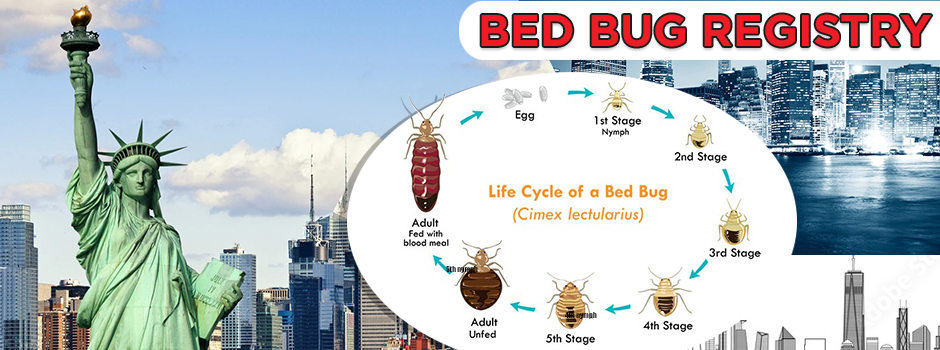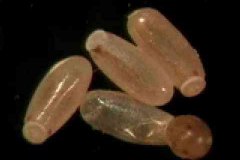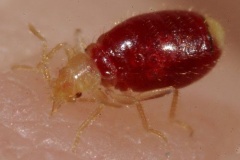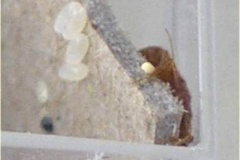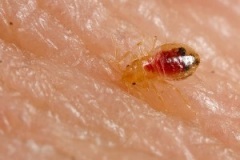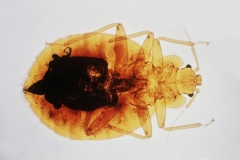Introduction
Sometimes referred to as "red coats," "chinches," or "mahogany flats" (USDA 1976), bed bugs, Cimex lectularius Linnaeus, are blood feeding parasites of humans, chickens, bats and occasionally domesticated animals (Usinger 1966). Bed bugs are suspected carriers of leprosy, oriental sore, Q-fever, and brucellosis (Krueger 2000) but have never been implicated in the spread of disease to humans (Dolling 1991). After the development and use of modern insecticides, such as DDT, bed bug infestations have virtually disappeared. However, since 1995, pest management professionals have noticed an increase in bed bug related complaints (Krueger 2000).
Adult bed bug, Cimex lectularius Linnaeus, feeding. Photography by: Joseph Smith, University of Florida
Human dwellings, birds nests, and bat caves make the most suitable habitats for bed bugs since they offer warmth, areas to hide, and most importantly hosts on which to feed (Dolling 1991). Bed bugs are not evenly distributed throughout the environment but are instead concentrated in harborages (Usinger 1966). Within human dwellings, harborages include cracks and crevices in walls, furniture, behind wallpaper and wood paneling, or under carpeting (Krueger 2000). Bed bugs are usually only active during night but will feed during the day when hungry (Usinger 1966). Bed bugs can be transported on clothing, in traveler's luggage, or in bedding and furniture (USDA 1976) but lack appendages to enable them to cling to hair, fur, or feathers, so are rarely found on hosts (Dolling 1991).
The adult bed bug is a broadly flattened, ovoid, insect with greatly reduced wings (Schuh and Slater 1995). The reduced fore wings, or hemelytra, are broader than they are long, with a somewhat rectangular appearance. The sides of the pronotum are covered with short, stiff hairs (Furman and Catts 1970). Before feeding, bed bugs are usually brown in color and range from 6 to 9.5 mm in length. After feeding, the body is often swollen and red in color (USDA 1976).
Dorsalview of an adult bed bug, Cimex lectularius Linnaeus. Photograph by: David Almquist, University of Florida
Lateral view of an adult bed bug, Cimex lectularius Linnaeus. Photograph by: Joseph Smith, University of Florida
Nymph of the bed bug, Cimex lectularius Linnaeus. Photograph by, Joseph Smith, University of Florida
The two bed bugs most important to man are the common bed bug, Cimex lectularius, and the tropical bed bug, Cimex hemipterus. These two species of bed bugs can easily be distinguished by looking at the prothorax, the first segment of the thorax. The prothorax of the common bed bug is more expanded laterally and the extreme margins are more flattened than that of the tropical bed bug (Ghauri 1973).
Because of their confined living spaces, copulation among male and female bed bugs is difficult. The female possesses a secondary copulatory aperture, Ribaga's organ or paragenital sinus, on the fourth abdominal sternum where spermatozoa from the male are injected. The spermatozoa then migrate to the ovaries by passing through the haemocoel, or body cavity (Dolling 1991). The female bed bug lays approximately 200 eggs during her life span at a rate of one to 12 eggs per day (Krueger 2000). The eggs are laid on rough surfaces and coated with a transparent cement to adhere them to the substrate (Usinger 1966). Within six to 17 days bed bug nymphs, almost devoid of color, emerge from the eggs. After five molts, which takes approximately ten weeks, the nymphs reach maturity (USDA 1976).
See original here:
EENY140/IN297: Bed Bug, Cimex lectularius Linneaus (Insecta ...

 Residence
Residence  Location
Location 
